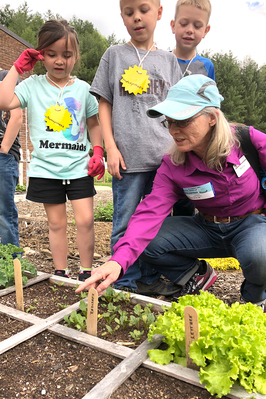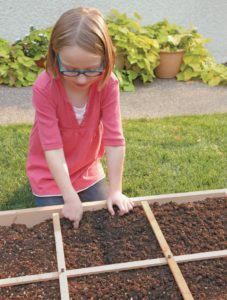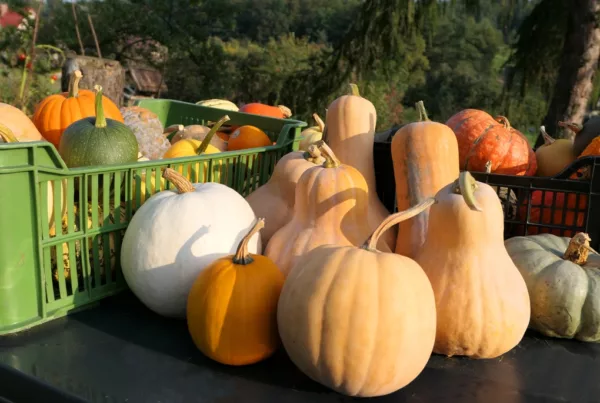 So you’re at home with the kids for, well, who knows how long? You know you need to plan some fun and hopefully educational things for them to do. What if you could do an activity with them that would teach them a myriad of life skills, benefit the entire family, and be loads of fun in the process? You can. It’s called Square Foot Gardening!
So you’re at home with the kids for, well, who knows how long? You know you need to plan some fun and hopefully educational things for them to do. What if you could do an activity with them that would teach them a myriad of life skills, benefit the entire family, and be loads of fun in the process? You can. It’s called Square Foot Gardening!
Now, if you’re totally new to this method of gardening, we suggest starting with getting a copy of All New Square Foot Gardening, 3rd Edition to familiarize yourself with the overall method, and then jump into Square Foot Gardening with Kids to learn even more! But until then, keep reading for a quick introduction.
Why Square Foot Gardening with Kids?
Sure, you could do general gardening with them and still have fun, but Square Foot Gardening goes beyond simply having fun — it’s a math, science, food, and self-sufficiency crash course cleverly disguised as an it’s-okay-to-get-dirty fun in the sun time. And traditional row gardening often includes not-so-fun weeding and maintenance chores, which are not exactly the best way to get your kids to be enthusiastic.
Among the skills your child can learn, with your supervision, through Square Foot Gardening:
- Basic construction (building a 3’ x 3’ box and the grid)
- Math (measuring materials, spacing out the plants, subdividing the squares)
- Planning (sourcing materials, organizing seeds, planning what to plant and when)
- Water conservation (how to properly water plants to avoid wasting it)
- Growing food (vegetables, fruits, herbs)
How to Get Started
 The basics of Square Foot Gardening are pretty simple. You’ll definitely want to refer to the books for more specifics and handy how-to’s, but here’s what you’ll need to do:
The basics of Square Foot Gardening are pretty simple. You’ll definitely want to refer to the books for more specifics and handy how-to’s, but here’s what you’ll need to do:
- Build a simple box. A 3’ x 3’ box, just 6″ high is the perfect size for a child. Your Square Foot Garden can be larger, but it’s best for kids to have a small box to begin for easy reach.
- Fill it with Mel’s Mix™. This growing medium has everything in it that plants need to grow strong and healthy — equal parts blended compost, coarse vermiculite, and peat moss. Mel’s Mix™ is the secret to success or something like that. Other than that, it’s good to go!
- Add a grid you make with your kids. The grid with 1-foot squares helps your kids learn to space out and organize their plantings — and keeps everything tidy in the process!
- Plant. Refer to the planting charts in the book, and plant one, four, nine, or sixteen plants per 1-foot square, depending upon the type of plant and its predicted size. We suggest the always-fun “Zip, Zap, Bing, Bing, Bing” method when planting — your child uses his or her finger to draw a line right down the middle of the square, and another line across it (zip, zap), forming four smaller squares within. Now she will use her finger to poke a hole in the center of each of those smaller squares for the seeds (bing, bing, bing).
- Maintain. Water each plant at the base to keep it growing. There’s usually no weeding necessary in a Square Foot Garden, but do be on the lookout for any pesky bugs (there’s another teaching moment there, just FYI).
- Harvest. What’s more fun than seeing those tomatoes develop? Going out and harvesting! Plan meals around your Square Foot Garden harvest, or simply enjoy snacking outside with Mother Nature.
Simple Teaching Tips
It’s not too difficult for you and your kids to have fun with the Square Foot Gardening method — fun is built right into it! Because the method is less labor-intensive and cuts the drudgery out, you’ll find that your whole family is eager to get out there. That being said, these teaching tips could help you get the most out of your experience:
Give each child their own box to “own.” Adults have their box, and the kids have theirs. What better way to foster a sense of ownership? Be on hand to guide them, but don’t take it over or do it for them.
Let the teaching be natural rather than forced. The garden classroom should always be fun. Look for the lessons as they naturally appear rather than sitting them down with a formal lesson.
Start small. Those smaller boxes are ideal for kids; they don’t need anything bigger. Let them feel accomplishment for the wins that come with a little 3’ x 3’ space, then build on it going forward.
Don’t aim for perfection. It doesn’t matter if the lines they draw aren’t straight or the hole isn’t exactly in the middle. Praise their efforts, and remember to connect their efforts to the excitement they feel when it’s harvest time! And now, you’ve created a life-long gardener…or at the least, a very happy and accomplished child.



